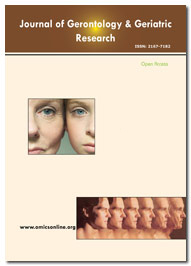Indexed In
- Open J Gate
- Genamics JournalSeek
- SafetyLit
- RefSeek
- Hamdard University
- EBSCO A-Z
- OCLC- WorldCat
- Publons
- Geneva Foundation for Medical Education and Research
- Euro Pub
- Google Scholar
Useful Links
Share This Page
Journal Flyer

Open Access Journals
- Agri and Aquaculture
- Biochemistry
- Bioinformatics & Systems Biology
- Business & Management
- Chemistry
- Clinical Sciences
- Engineering
- Food & Nutrition
- General Science
- Genetics & Molecular Biology
- Immunology & Microbiology
- Medical Sciences
- Neuroscience & Psychology
- Nursing & Health Care
- Pharmaceutical Sciences
Brief Report - (2024) Volume 13, Issue 3
The Role of Technology in Reducing Social Isolation among Older Adults
Tim Chung*Received: 01-Jun-2024, Manuscript No. jggr-24-27521; Editor assigned: 03-Jun-2024, Pre QC No. P-27521; Reviewed: 15-Jun-2024, QC No. Q-27521; Revised: 21-Jun-2024, Manuscript No. R-27521; Published: 28-Jun-2024, DOI: 10.35248/2167-7182.2024.13.739
Introduction
Social isolation among older adults is a pressing public health issue, exacerbated by factors such as physical limitations, loss of loved ones, and geographical distance from family and friends. The COVID-19 pandemic has further highlighted the vulnerabilities of this demographic, prompting a renewed focus on interventions aimed at alleviating isolation. Technology has emerged as a pivotal tool in bridging the gap between older adults and their social networks. This review article explores the various ways technology can reduce social isolation among older adults, examines existing literature, and discusses the potential and challenges of these interventions. Social isolation is defined as the lack of social connections and interactions, which can lead to significant physical and mental health issues, including depression, anxiety, and cognitive decline.
The aging population is particularly susceptible due to various factors Physical Health Decline Chronic illnesses can limit mobility and the ability to engage in social activities. Loss of Spouses and Friends Grief and loss can reduce social interactions. Geographical Separation Adult children may live far away, making regular visits challenging. Technological Barriers Some older adults may lack the skills or confidence to use technology effectively. Video calling platforms such as Zoom, Skype, and FaceTime have become essential during the pandemic, allowing older adults to maintain face-to-face interactions with family and friends. Research indicates that video calls can reduce feelings of loneliness and enhance emotional connections. The visual component adds a layer of intimacy that text-based communication lacks [1].
Social media platforms like Facebook and Instagram can also serve as avenues for connection. A study found that older adults who actively engage with social media report higher levels of social support and decreased feelings of loneliness. However, the benefits are contingent upon the users’ ability to navigate these platforms effectively. The internet has facilitated the formation of online communities where older adults can share experiences, interests, and challenges. Websites such as Reddit, Facebook groups, and dedicated forums provide spaces for connection and support [2]. Research shows that participation in online support groups can mitigate feelings of isolation. These communities can be particularly valuable for those with specific interests or health conditions, fostering a sense of belonging and understanding.
Description
Telehealth has revolutionized access to healthcare for older adults, allowing them to connect with healthcare providers without the need for physical travel. This can alleviate isolation by ensuring that health issues do not prevent social engagement. Studies indicate that telehealth can enhance older adults' quality of life and reduce feelings of isolation by enabling consistent health management. Social robots, such as Paro the robotic seal and ElliQ, are designed to engage older adults in conversation and provide companionship. These technologies have shown promise in reducing loneliness, particularly among those with cognitive impairments. Although the technology is still in its infancy, preliminary studies suggest that interactions with social robots can lead to improved emotional well-being [3,4].
Virtual Reality (VR) technologies offer immersive experiences that can connect older adults with distant family members or allow them to explore new environments. Research indicates that VR experiences can evoke positive emotions and foster social connections, making them a valuable tool for reducing isolation. Online gaming platforms and interactive entertainment can also facilitate socialization. Many older adults engage in multiplayer online games, which can serve as a source of enjoyment and a means to meet new people. A study conducted by highlights how gaming communities can provide social support and companionship, ultimately contributing to reduced feelings of isolation [5].
Despite the potential benefits of technology in reducing social isolation, several barriers hinder its widespread adoption among older adults Digital Literacy Many older adults lack the necessary skills to use technology effectively, leading to frustration and disengagement. Programs that offer training in digital literacy can mitigate this barrier. Accessibility Not all older adults have access to the internet or devices. Ensuring that affordable technology and internet access are available is crucial. Health Issues Cognitive decline or physical impairments can make it challenging for older adults to engage with technology. Attitudinal Barriers Some older adults may have negative perceptions of technology or believe it is not for them, which can prevent engagement.
To maximize the benefits of technology in reducing social isolation among older adults, several recommendations can be made developing training programs tailored to older adults' specific needs can help bridge the digital divide. These programs should focus on building confidence and skills, covering topics from basic device use to navigating social media platforms. Local organizations and communities can play a pivotal role in providing resources and support. Creating community centers that offer technology workshops, social events, and access to devices can foster engagement. Healthcare providers should incorporate technology use into their care plans, recommending platforms that facilitate social connection. Telehealth services should be integrated with social support resources, ensuring holistic care.
Conclusion
Technology holds significant promise in addressing the social isolation faced by older adults. From communication tools to online communities, the digital landscape offers numerous avenues for connection and support. However, barriers to technology adoption must be addressed to fully realize these benefits. By fostering digital literacy, providing community support, and ensuring accessibility, we can harness the power of technology to enhance the quality of life for older adults and alleviate social isolation. As we move forward, a collaborative effort among stakeholders—including technology developers, healthcare providers, and community organizations—will be essential in creating an inclusive digital environment that meets the needs of older adults.
Acknowledgement
None.
Conflict of Interest
None.
References
- Rico-Uribe LA, Caballero FF, Martín-María N, Cabello M, Ayuso-Mateos JL, Miret M. Association of loneliness with all-cause mortality: A meta-analysis. PloS One. 2018;13:e0190033.
- Conn DK, Hogan DB, Amdam L, Cassidy KL, Cordell P, Frank C, et al. Canadian guidelines on benzodiazepine receptor agonist use disorder among older adults title. Can Geriatr J. 2020;23:116.
- Hoang P, King JA, Moore S, Moore K, Reich K, Sidhu H, et al. Interventions associated with reduced loneliness and social isolation in older adults: A systematic review and meta-analysis. JAMA Network Open. 2022;5:e2236676.
- Bethell J, Aelick K, Babineau J, Bretzlaff M, Edwards C, Gibson JL, et al. Social connection in long-term care homes: A scoping review of published research on the mental health impacts and potential strategies during COVID-19. J Am Med Dir Assoc. 2021;22:228-237.
- Shen C, Rolls ET, Cheng W, Kang J, Dong G, et al. Associations of social isolation and loneliness with later dementia. Neurology. 2022;99:e164-e175.
Google Scholar, Crossref, Indexed at
Google Scholar, Crossref, Indexed at
Google Scholar, Crossref, Indexed at
Google Scholar, Crossref, Indexed at
Citation: Chung T (2024). The Role of Technology in Reducing Social Isolation among Older Adults. J Gerontol Geriatr Res. 13: 739.
Copyright: © 2024 Chung T. This is an open-access article distributed under the terms of the Creative Commons Attribution License, which permits unrestricted use, distribution, and reproduction in any medium, provided the original author and source are credited.

